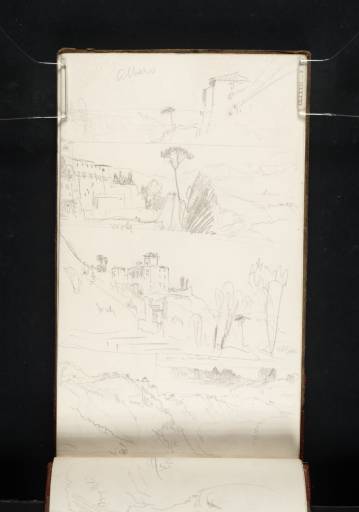Joseph Mallord William Turner Five Sketches of Lake Albano, Including the Monastery and Tomb at Palazzola 1819
Joseph Mallord William Turner,
Five Sketches of Lake Albano, Including the Monastery and Tomb at Palazzola
1819
Joseph Mallord William Turner 1775–1851
Folio 9 Recto:
Five Sketches of Lake Albano, Including the Monastery and Tomb at Palazzola 1819
D15311
Turner Bequest CLXXXII 9
Turner Bequest CLXXXII 9
Pencil on white wove paper, 189 x 113 mm
Inscribed by the ?artist in pencil ‘9’ bottom left and by the artist ‘Albano’ top centre, ‘wall’ below second sketch from top and ‘sea’ centre right of second sketch from top, ‘wall’ and ‘[?Vines]’ centre left of third sketch from top and ‘L Albano’ bottom right of third sketch from top and ‘Sea [?as] [?Continuation]’ top of fourth sketch from top and ‘wood’ bottom centre left and ‘Sea’ right of bottom sketch
Inscribed by John Ruskin in blue ink ‘9’ top left, ascending left-hand edge and ‘301’ top right, ascending right-hand edge
Stamped in black ‘CLXXXII 9’ top right, ascending right-hand edge
Inscribed by John Ruskin in blue ink ‘9’ top left, ascending left-hand edge and ‘301’ top right, ascending right-hand edge
Stamped in black ‘CLXXXII 9’ top right, ascending right-hand edge
Accepted by the nation as part of the Turner Bequest 1856
References
1909
A.J. Finberg, A Complete Inventory of the Drawings of the Turner Bequest, London 1909, vol.I, p.536, as ‘Five Sketches of Lake Albano’.
1974
Gerald Wilkinson, The Sketches of Turner, R.A. 1802–20: Genius of the Romantic, London 1974, reproduced p.186 bottom, as ‘Lago Albano’.
1977
Gerald Wilkinson, Turner Sketches 1789–1820, London 1977, p.[158], reproduced p.156 bottom, as ‘Albano’.
1979
Andrew Wilton, The Life and Work of J.M.W. Turner, Fribourg 1979, p.384 no.731.
1984
Cecilia Powell, ‘Turner and the Bandits: ‘Lake Albano’ rediscovered’, Turner Studies, Summer 1984, vol.3, no.2, p.23.
1984
Cecilia Powell, ‘Turner on Classic Ground: His Visits to Central and Southern Italy and Related Paintings and Drawings’, unpublished Ph.D thesis, Courtauld Institute of Art, University of London 1984, pp.194 note 102, 196 note 110, 262 note 123.
1987
Cecilia Powell, Turner in the South: Rome, Naples, Florence, New Haven and London 1987, pp.[88] note 78, 89 note 81.
2000
David Hill, Joseph Mallord William Turner: Le Mont-Blanc et la Vallée d’Aoste, exhibition catalogue, Museo Archeologico Regionale, Aosta / Musée Archéologique Régional, Aoste 2000, p.295.
2008
Nicola Moorby, ‘Un tesoro italiano: i taccuini di Turner’, in James Hamilton, Nicola Moorby, Christopher Baker and others, Turner e l’Italia, exhibition catalogue, Palazzo dei Diamanti, Ferrara 2008, p.98, reproduced in colour fig.63 as ‘Cinque bozzetti del lago d’Albano con il monastero di Palazzola’.
2009
Nicola Moorby, ‘An Italian Treasury: Turner’s sketchbooks’, in James Hamilton, Nicola Moorby, Christopher Baker and others, Turner & Italy, exhibition catalogue, National Galleries of Scotland, Edinburgh 2009, p.111, reproduced in colour p.112, pl.124, as ‘Five Sketches of Lake Albano, including the Monastery and Tomb at Palazzola’.
Turner circled Lake Albano and made sketches from several different points. The subject and viewpoint for the five sketches on this page is the monastery of Palazzola, a medieval church on the eastern perimeter of the lake which had been built upon the ruins of an Roman ancient villa (today it is a retreat and summer residence used by the Venerable English College). In the third sketch from the top, just beneath the monastery, can be seen the semi-pyramidal structure of a large ancient tomb carved into the slopes of the adjacent gardens.1 This sepulchre, which can still be seen today, is decorated with fasces (bundles of rods symbolising power) and probably dates from the second century BC, and may be that of Consul Cornelius Scipio Hispalus.2 It had already been depicted by Piranesi in his Antichità d’Albano e di Castel Gandolfo 1764,3 and in a coloured aquatint by John Izard Middleton, published in Grecian Remains in Italy: A Description of Cyclopian Walls and of Roman Antiquities, with Topographical and Picturesque Views of Ancient Latium, London 1812.4
The two sketches at the bottom of the page suggest that Turner was working at the end of the day as the light was fading. The small drawing of Castel Gandolfo shows the dark silhouette of the town in shadow, which would be consistent with the sun setting in the west beyond. Meanwhile the sketch of Albano beneath appears to show the sun low in the sky with the reflection on the water below.
For a full discussion of Turner’s depictions of Lake Albano see folio 3 verso (D15301) and the general introduction to the sketchbook.
Nicola Moorby
May 2008
See a drawing of a similar view by Charles Joseph Lecointe, see Francesco Petrucci e Susanna Marra, Vedute dei Colli Albani e di Roma dall’album di viaggio di Charles Joseph Lecointe (1824–1886), exhibition catalogue, Palazzo Chigi, Ariccia 2006, no.15, p.33, reproduced.
Thomas Ashby, The Roman Campagna in Classical Times, 2nd edition, London and New York 1927, p.196. See photograph in Oreste Ferrari, Tea Marintelli, Valerie Scott et al., Thomas Ashby: Un Archeologo Fotografa la Campagna Romana Tra ’800 e’900, Rome 1986, p.167, no.132 fig.3.
How to cite
Nicola Moorby, ‘Five Sketches of Lake Albano, Including the Monastery and Tomb at Palazzola 1819 by Joseph Mallord William Turner’, catalogue entry, May 2008, in David Blayney Brown (ed.), J.M.W. Turner: Sketchbooks, Drawings and Watercolours, Tate Research Publication, December 2012, https://www

